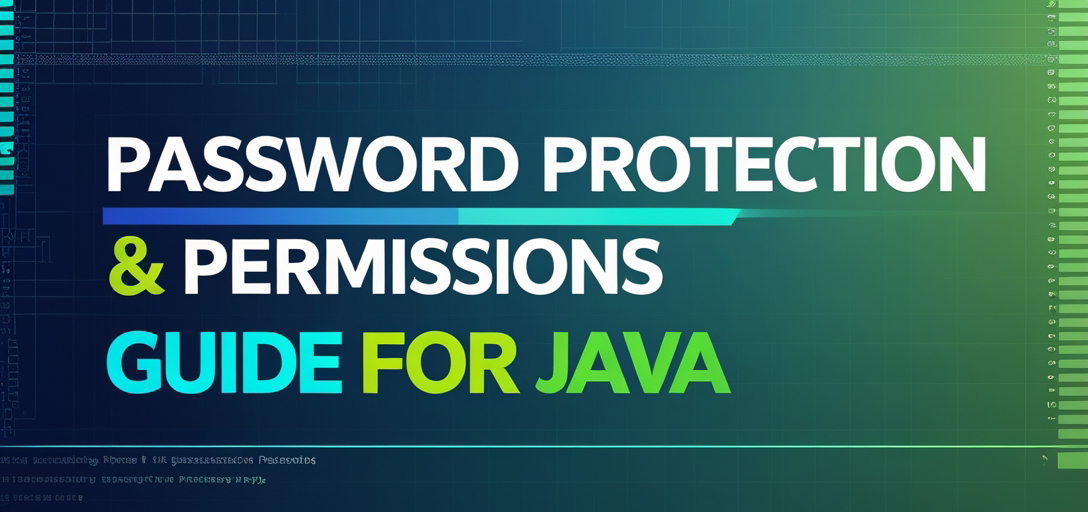Secure Your PDFs with GroupDocs.Viewer in Java
Introduction
Are you concerned about unauthorized access to your sensitive PDF documents? Implementing document protection is crucial for maintaining confidentiality and ensuring that only authorized users can view or modify the content. This tutorial will guide you through using GroupDocs.Viewer for Java to effectively protect a PDF document with passwords and restricted permissions.

In this guide, you’ll learn:
- How to set up GroupDocs.Viewer for Java
- Steps to secure your PDF documents using password protection
- Configuring permissions to restrict actions like printing
Let’s start by ensuring you have everything needed!
Prerequisites
Before we begin, ensure that you have the following in place:
Required Libraries and Dependencies
You’ll need GroupDocs.Viewer for Java. If you’re managing your project with Maven, add the following dependencies to your pom.xml file:
<repositories>
<repository>
<id>repository.groupdocs.com</id>
<name>GroupDocs Repository</name>
<url>https://releases.groupdocs.com/viewer/java/</url>
</repository>
</repositories>
<dependencies>
<dependency>
<groupId>com.groupdocs</groupId>
<artifactId>groupdocs-viewer</artifactId>
<version>25.2</version>
</dependency>
</dependencies>
Environment Setup
Make sure you have Java installed on your system and an IDE like IntelliJ IDEA or Eclipse for development.
Knowledge Prerequisites
A basic understanding of Java programming, familiarity with Maven projects, and experience working with PDFs will be beneficial.
Setting Up GroupDocs.Viewer for Java
To start using GroupDocs.Viewer in a new project, follow these steps:
Include the Dependency: Ensure your
pom.xmlincludes the necessary repository and dependency as shown above.License Acquisition:
- You can start with a free trial by downloading a temporary license from GroupDocs.
- For long-term use, consider purchasing a subscription on the GroupDocs Purchase page.
Basic Initialization: Initialize GroupDocs.Viewer in your Java application to start viewing documents.
import com.groupdocs.viewer.Viewer;
import java.nio.file.Path;
public class ViewerSetup {
public static void main(String[] args) {
Path filePath = Path.of("path/to/your/document.docx");
try (Viewer viewer = new Viewer(filePath)) {
// Your viewing logic here
}
}
}
Implementation Guide
Step 1: Set Up the Output Directory and File Path
First, determine where you want to save your protected PDF document:
import java.nio.file.Path;
import java.nio.file.Paths;
public class ProtectPdfDocument {
public static void main(String[] args) {
// Define output directory path
Path YOUR_OUTPUT_DIRECTORY = Paths.get("output/directory/path");
Path filePath = YOUR_OUTPUT_DIRECTORY.resolve("protected_output.pdf");
// Proceed with further steps...
}
}
Step 2: Configure Security Settings for the PDF Document
Set up security configurations to protect your document:
import com.groupdocs.viewer.options.Security;
import com.groupdocs.viewer.options.Permissions;
public class ProtectPdfDocument {
public static void configureSecurity(Security security) {
security.setDocumentOpenPassword("o123"); // Set a password required to open the document
security.setPermissionsPassword("p123"); // Set a permissions password
// Allow all actions except printing
security.setPermissions(Permissions.ALLOW_ALL ^ Permissions.DENY_PRINTING);
}
}
Step 3: Create View Options for Rendering
Create view options to apply the security settings:
import com.groupdocs.viewer.options.PdfViewOptions;
public class ProtectPdfDocument {
public static void createViewOptions(Security security, Path filePath) {
PdfViewOptions viewOptions = new PdfViewOptions(filePath);
viewOptions.setSecurity(security);
// Use these view options to render the document
}
}
Step 4: Render the Source Document
Finally, use GroupDocs.Viewer to generate a protected PDF:
import com.groupdocs.viewer.Viewer;
public class ProtectPdfDocument {
public static void main(String[] args) {
Path YOUR_OUTPUT_DIRECTORY = Paths.get("output/directory/path");
Path filePath = YOUR_OUTPUT_DIRECTORY.resolve("protected_output.pdf");
Security security = new Security();
configureSecurity(security);
try (Viewer viewer = new Viewer("path/to/input/document.docx")) {
PdfViewOptions viewOptions = new PdfViewOptions(filePath);
viewOptions.setSecurity(security);
viewer.view(viewOptions); // Render and save the output as a protected PDF
}
}
public static void configureSecurity(Security security) {
security.setDocumentOpenPassword("o123");
security.setPermissionsPassword("p123");
// Allow all actions except printing
security.setPermissions(Permissions.ALLOW_ALL ^ Permissions.DENY_PRINTING);
}
}
Practical Applications
- Legal Documents: Protect sensitive legal documents from unauthorized modifications.
- Financial Reports: Secure financial reports and share them with stakeholders without risking data breaches.
- Educational Materials: Distribute course materials that can only be viewed by enrolled students.
Performance Considerations
- Optimize performance by ensuring your Java environment is adequately resourced, such as having sufficient memory allocated for larger documents.
- Use best practices like disposing of resources properly and minimizing redundant processing to enhance efficiency with GroupDocs.Viewer.
Conclusion
In this guide, we’ve explored how to protect PDF documents using passwords and permissions with GroupDocs.Viewer for Java. This approach is invaluable in maintaining document security across various industries. Now that you’re equipped with these skills, consider integrating additional features such as watermarking or conversion capabilities provided by GroupDocs.Viewer.
FAQ Section
- What are the benefits of using GroupDocs.Viewer?
- Provides robust viewing and protection options for documents.
- Can I use GroupDocs.Viewer in a commercial project?
- Yes, with appropriate licensing from GroupDocs.
- How do I handle errors during document rendering?
- Use try-catch blocks to manage exceptions and ensure resources are closed properly.
- Is it possible to customize the permissions further?
- Yes, GroupDocs.Viewer allows fine-tuned control over permissions like copying text or modifying content.
- Can I view non-PDF documents using GroupDocs.Viewer Java?
- Absolutely! It supports a wide range of document formats including Word, Excel, and more.